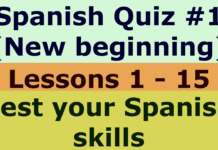CORRECT ANSWER:
D) Quiero una manzana para después.
The Spanish verb “querer” (to want) is irregular, because to conjugate it we need to add a letter “i” and modify its root (“quer“). However, there is a regular pattern here. Because all Spanish verbs that finish with “erer” follow the same rule. Like, for example, the Spanish verbo “verter” (to pour).
The Spanish preposition “para” means “for” and “in order to”. But the “for” as in “this is for you”. Not the “for” as in “for example”.
For example:
– Esto es para ti = This is for you
– Para que funcione hay que encenderlo = For it to work you have to turn it on (in order to)
– Quiero esta manzana después = I want this apple later
– Quiero esta manzana para después = I want this apple for later
Like in English, “querer” is a very important modal verb. And it can be used with a noun or with a verb.
For example:
– Quiero una manzana = I want an apple
– Quiero comer una manzana = I want to eat an apple
Related Spanish video-lessons that you may watch:
– Lesson 11: Using Spanish prepositions “A” & “PARA” (to/for)
– Lesson 18: Spanish verb “querer” TO WANT
– Lesson 157 – Spanish Modal Verbs – Videos 1 & 2
– Lesson 158 – Spanish Modal Verb PODER (CAN) – Videos 1 & 2
– Lesson 159 – Spanish Modal Verb QUERER (to want) – Videos 1 & 2
– Lesson 279 – Spanish modal verb HAY QUE













